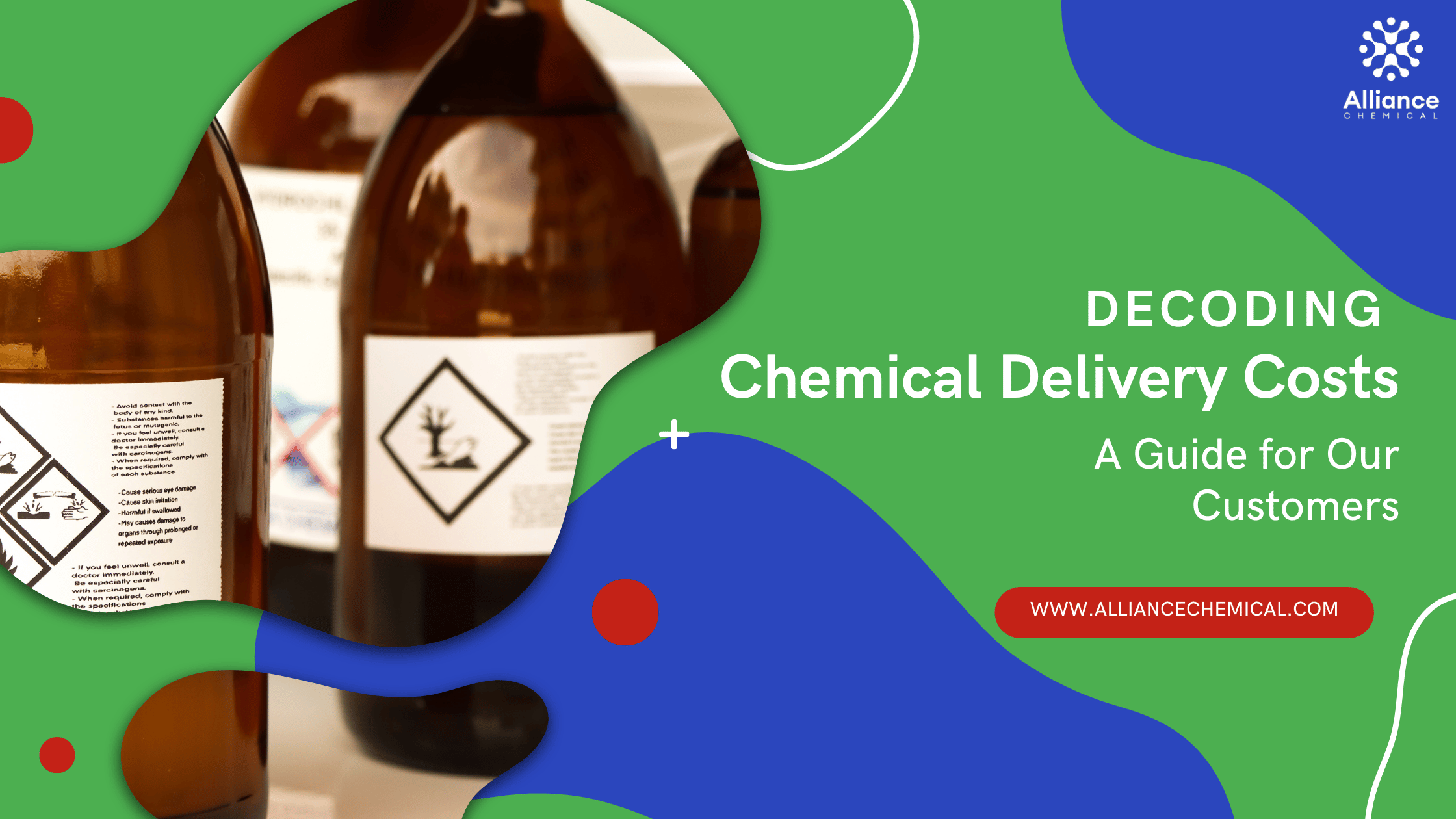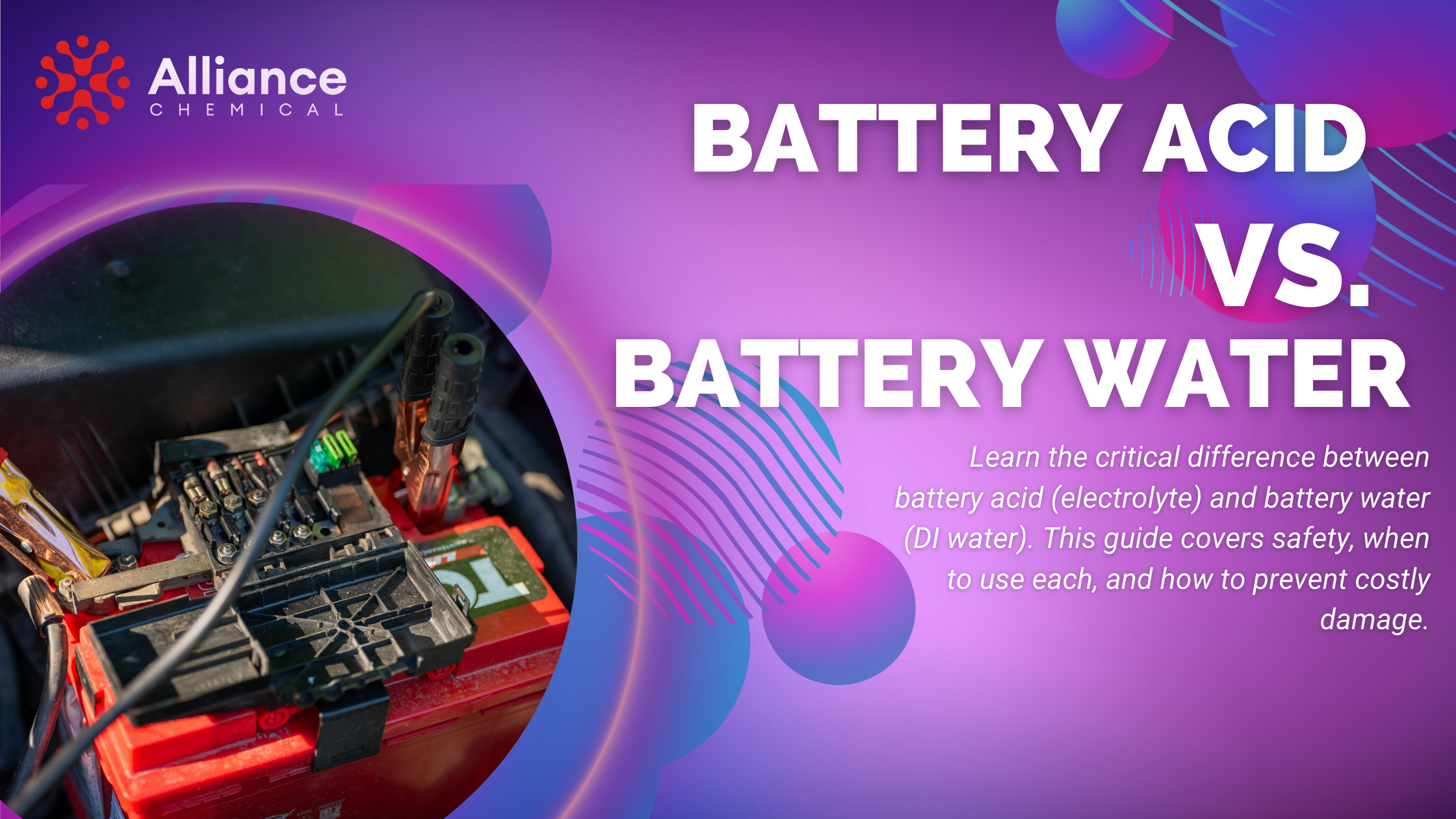
Decoding Chemical Delivery Costs: A Guide for Our Customers
Table of Contents
Summary
Shipping chemicals involves more than just weight and distance. This guide unpacks why gallon-sized orders can incur higher fees due to Hazmat rules, and how smaller quart sizes might be a more economical choice for parcel delivery.
Welcome: Navigating Chemical Shipping with Alliance Chemical
At Alliance Chemical, ensuring your chemical orders arrive safely and efficiently is a top priority. We also recognize that shipping fees, especially for larger volumes like gallons of industrial chemicals, can sometimes seem unexpectedly high. You might find a gallon priced competitively, but the final shipping cost via carriers like UPS raises questions. In contrast, ordering the same total volume in individual quarts can often lead to a more predictable shipping expense.
This discrepancy isn't a whim; it's rooted in the complex web of regulations governing the transportation of chemicals. These rules, designed for universal safety, significantly influence shipping procedures and costs. This article aims to clarify these factors, especially the impact of "Hazardous Materials" (Hazmat) classifications on gallon versus quart shipments.

Our Pledge to Transparency
We believe in open communication. Understanding these shipping nuances empowers you to make the best purchasing choices for your needs. Our aim is to deliver the chemicals you require, compliantly and effectively.
Shipping Basics: Beyond Standard Parcels
For everyday, non-hazardous items, shipping charges are generally straightforward, based on package weight, dimensions, and travel distance. However, the equation changes for many chemical products due to vital Hazardous Materials (Hazmat) regulations.
These are not policies unique to Alliance Chemical or shipping companies. They are strict mandates enforced by regulatory authorities to safeguard everyone involved in the transit chain and the wider public. Key bodies include:
- U.S. Department of Transportation (DOT): Oversees ground transportation in the USA.
- International Air Transport Association (IATA): Dictates air freight protocols.
- International Maritime Dangerous Goods (IMDG) Code: Governs shipments by sea.
Carriers such as UPS, FedEx, and LTL freight providers are legally obligated to adhere to these comprehensive standards. The core objective is always safety—preventing harm to handlers, transport staff, communities, and the environment from the inherent risks of certain chemicals.
Hazmat Deep Dive: Defining Hazardous for Transport
A chemical earns a "Hazardous Material" designation for shipping if its inherent properties could present an undue risk during its journey. This encompasses substances that are:
- Flammable (e.g., various alcohols, ketones, and other solvents)
- Corrosive (such as potent acids and strong bases)
- Toxic or Poisonous
- Oxidizing Agents
- Chemically Reactive
- Pressurized Gases
Every hazardous material receives a UN identification number, an official shipping name, a specific hazard class, and a packing group (PG I, II, or III—denoting high, moderate, or low danger). This classification dictates the precise packaging, labeling, and documentation needed for compliant shipment.
Essential Hazmat Shipping Protocols:
When a product ships under full Hazmat regulations, several stringent measures are mandatory:
- UN-Specification Packaging: Containers rigorously tested and certified to endure transport stresses.
- Distinctive Labeling: Diamond-shaped hazard pictograms clearly indicating the risks.
- Comprehensive Shipping Documents: Detailed paperwork accurately describing the material.
- Certified Shipping Personnel: Individuals with up-to-date Hazmat training must prepare and offer the shipment.
- Carrier Hazmat Fees: Substantial extra charges applied by carriers for the specialized handling of Hazmat goods.
Size Matters: The Gallon vs. Quart Shipping Difference
This is where the plot thickens regarding shipping costs, especially when using parcel carriers like UPS for common chemical volumes.
Many chemicals, despite being classified as hazardous, can be shipped under "Limited Quantity" exemptions. These provisions apply if the volume per inner container and the overall package weight remain below specific thresholds. Limited Quantity shipments often benefit from simplified marking and labeling and, most importantly, can bypass the significant Hazmat surcharges from carriers.
- Quart-Sized Containers (approx. 1 Liter): For numerous chemicals, a quart container fits within the "Limited Quantity" per-inner-package limits for its particular hazard class and packing group. This means ordering, for example, four separate quarts might allow them to be packaged together in a way that still qualifies for Limited Quantity shipping, leading to lower delivery costs primarily driven by weight and dimensions.
- Gallon-Sized Containers (approx. 3.785 Liters): A single gallon jug frequently surpasses the Limited Quantity inner packaging allowance for that same chemical. Once this limit is exceeded, the entire package—even if it's just one gallon—must be treated as fully regulated Hazmat. This instantly activates all associated protocols and, crucially, the carrier's Hazmat surcharge, which can be quite steep.
The Critical Point: Why Gallons Can Trigger Higher Fees
The chemical's nature doesn't change, but the applicable regulations do based on the volume in a single container. A gallon often pushes a shipment beyond the "Limited Quantity" threshold, whereas four separate quarts (when appropriately packaged) might individually remain below it. This is a primary reason for the surprising shipping costs when ordering certain products in gallon sizes via UPS or FedEx.
For instance, a Packing Group II flammable liquid might have a Limited Quantity inner packaging limit of 1 liter. Four 1-quart (0.946L) bottles could potentially ship under Limited Quantity rules. However, a single 1-gallon (3.785L) bottle of the identical liquid would exceed this 1L limit, necessitating full Hazmat shipping procedures and fees.
This distinction is most pronounced for parcel carriers. For significantly larger orders (e.g., drums, totes), Less-Than-Truckload (LTL) freight is utilized, operating under its own Hazmat regulations and pricing, often more cost-effective per unit for substantial quantities.
Cost Elements: Deconstructing Extra Hazmat Shipping Charges
When a shipment falls under full Hazmat regulations (frequently the case for gallons of certain chemicals shipped by parcel), several components contribute to the increased expense:
- Carrier Hazmat Surcharges: This is usually the most significant added cost. UPS, FedEx, and similar carriers impose a substantial flat fee per package for managing regulated hazardous materials. This fee offsets their increased liability, specialized handling requirements, and extensive compliance efforts. Such fees can often range from $40 to $50 or more *per package*.
- UN-Rated Packaging Materials: Hazmat shipments mandate UN-specification packaging, which is inherently more robust and costlier than standard shipping boxes. This can include specialized absorbent materials, reinforced containers, or specific certifications for the boxes themselves.
- Precise Labeling and Documentation: Accurate Hazmat labels must be affixed, and meticulous shipping papers prepared. This process is time-consuming and necessitates personnel trained in these specific requirements.
- Specialized Handling & Employee Training: Our staff involved in preparing Hazmat shipments undergo specialized training and certification, an operational investment. Carriers also employ specially trained personnel and implement distinct handling procedures for these goods.
- Potential Service Limitations: Certain Hazmat items may be restricted from air transport or have limitations on available service levels, which can narrow options and occasionally extend transit times.
Smart Ordering: Alliance Chemical's Approach & Your Options
At Alliance Chemical, our unwavering commitment is to safety and complete adherence to all shipping regulations. We cannot, and will not, circumvent these critical rules. Our shipping department is expertly trained to pack your orders correctly and as cost-effectively as possible within these regulatory frameworks.
Strategies for Managing Your Chemical Shipping Expenses:
- Explore the "Quart Strategy": If your requirement is for a gallon or two of a product that is classified as Hazmat in gallon sizes, investigate the shipping cost for ordering the equivalent volume in quarts (e.g., 4 x 1-quart bottles instead of 1 x 1-gallon jug). While the product cost per quart might be marginally higher, the savings on Hazmat shipping fees could result in a lower overall "landed cost" for parcel deliveries.
- Consult Product Safety Data Sheets (SDS): The SDS for any chemical product (readily available on our website or upon request) includes vital transportation information in Section 14. This section details if a product is hazardous for transport. While technical, it is the definitive guide.
- Calculate the Total Landed Cost: Always assess the complete cost: product price + shipping charges + any applicable taxes. A seemingly cheaper gallon might not be the most economical choice once Hazmat shipping fees are applied for parcel services.
- Consolidate Wisely: Ordering multiple products together can reduce base shipping costs. However, if adding one fully Hazmat item (or an item that pushes the entire order into a Hazmat classification) drastically inflates the shipping cost, consider if splitting orders or opting for quart sizes of the problematic item is more economical.
- Bulk Quantities (Drums, Totes): For larger volume needs (e.g., 5-gallon pails, 55-gallon drums, intermediate bulk containers/totes), these are typically dispatched via LTL freight. Hazmat rules are still in effect, but the cost structure is different and generally more favorable per unit for true bulk. Please contact us for a tailored freight quote for these larger quantities.
- We're Here to Help! If you're uncertain about the most cost-effective way to order specific products and quantities while managing shipping expenses, please don't hesitate to connect with our customer service team. We can clarify the options available.
FAQs: Your Shipping Questions Answered
Why does UPS shipping for my 1-gallon chemical order seem so high?
The most common reason is that the 1-gallon container size for that particular chemical likely exceeds "Limited Quantity" exceptions. This forces it to be shipped as fully regulated Hazmat, incurring significant surcharges from UPS for their specialized handling, documentation, and associated risks. In contrast, four individual quarts of the same chemical might qualify for less restrictive shipping, resulting in lower costs.
Can Alliance Chemical simply ship my order cheaper by ignoring Hazmat rules?
No, under no circumstances. We are legally and ethically bound to full compliance with all DOT and carrier regulations. Attempting to bypass these rules carries severe penalties and, more critically, jeopardizes the safety of handlers, the public, and the environment. Safety is our paramount concern.
Is it always more economical to buy several quarts instead of one gallon?
Not universally, but it's often the case for parcel shipments (like UPS/FedEx) of chemicals that become fully Hazmat when packaged in gallon sizes. The key is to compare the total cost (product price + shipping fee) for both scenarios. For very large volumes, LTL freight for gallons or drums generally becomes more cost-effective per unit than numerous individual quarts.
What if I need a substantial amount of a chemical, like 20 gallons or a full drum?
For quantities such as 5-gallon pails, 55-gallon drums, or totes, we utilize Less-Than-Truckload (LTL) freight shipping. This system is distinct from parcel shipping and is designed for bulk transport. Hazmat regulations still apply, but the pricing structure is better suited to large, heavy consignments. Please request a freight quote from us for such orders.
How can I determine if a chemical is classified as Hazmat for shipping purposes?
The definitive source is Section 14 (Transport Information) of the product's Safety Data Sheet (SDS). This section clearly lists the UN number, proper shipping name, hazard class, and packing group. Our product descriptions may also provide shipping restriction details. If you remain unsure, our team is happy to assist.
Partnering for Clear and Compliant Chemical Shipping
We trust this detailed guide illuminates why chemical shipping costs, especially for gallon-sized containers sent via parcel services, can be more substantial than anticipated. The rigorous safety regulations governing Hazardous Materials are indispensable, and full compliance is a responsibility we take very seriously.
Alliance Chemical is committed to supplying you with high-quality chemicals, from food-grade ingredients to specialized research chemicals, while ensuring every shipment is handled safely and in accordance with all regulations. By understanding these shipping dynamics, you can make more informed purchasing decisions and explore options like quart sizing to potentially optimize your overall costs for smaller parcel deliveries.
Our knowledgeable team is always ready to support you. Should you have any questions regarding the shipping of a specific product or an existing order, please feel free to reach out.
Questions About Shipping or Ready to Place an Order?
Browse our extensive catalog of chemical products or contact our dedicated team for personalized assistance with your order and any shipping inquiries.
Explore Our Chemicals Get In Touch








